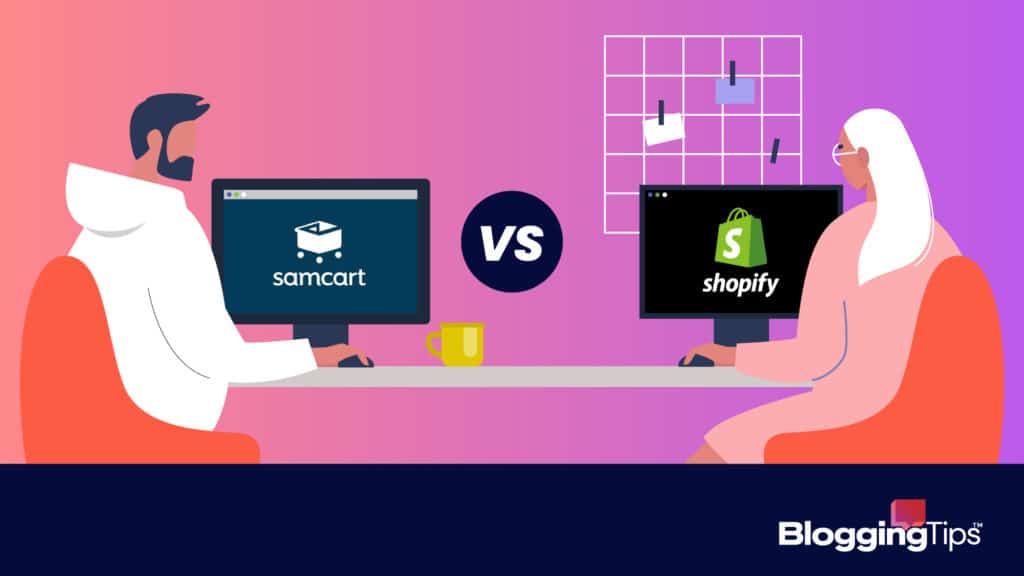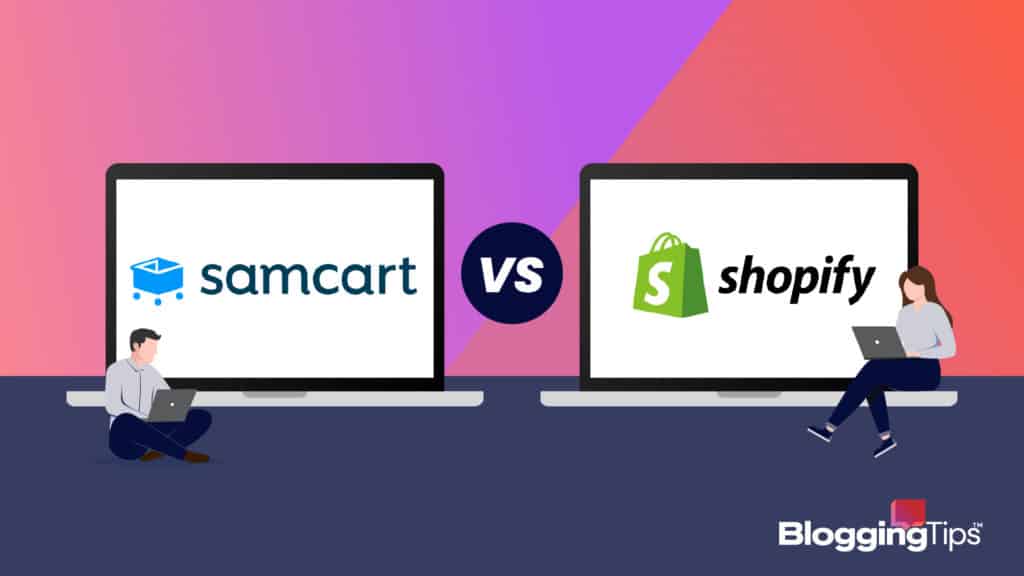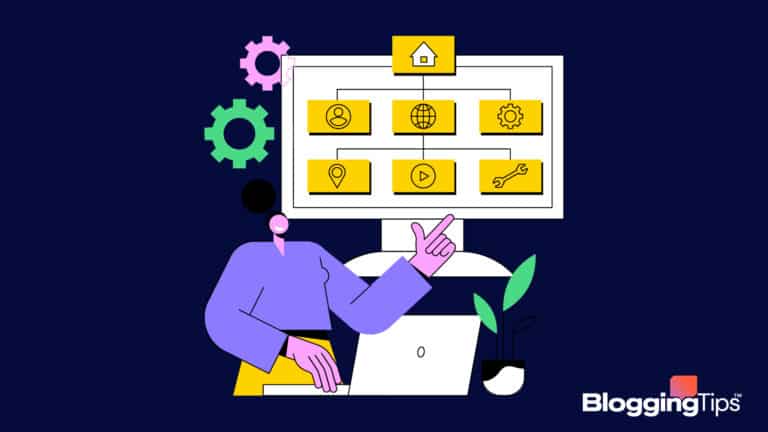Before you list your first product for sale online, consider SamCart vs Shopify.
Both platforms let you sell products, but they’re very different.
SamCart is simple and great for individual products.
On the other hand, Shopify is more popular and great for full businesses.
Keep reading to help decide which tool is better for you.
SamCart vs Shopify: An Overview
When it comes to comparing SamCart and Shopify, it helps to start with an overview.
Then, you may get a good idea of which ecommerce platform to choose.
Consider the following aspects of each platform for your online store.
SamCart
SamCart has been around since 2004 and really got going in 2014.
It’s grown quickly, and it’s become an excellent tool to set up and run your online business.
You don’t need a lot to start using this tool.
Here’s what you need to know about SamCart.
What Is SamCart?
SamCart is a tool you can use to create a sales page for a product.
It started as a way to take payments directly within a sales funnel.
However, the company has expanded to work for a membership site or as a landing page.
You can use the tool to make your checkout page more interesting than the PayPal page, for example.
The tool also lets you upsell or do AB testing to help increase your revenue.
It’s an excellent option for people who don’t know how to code.
Plus, you can set up individual landing pages for each digital product you want to sell.
What Makes SamCart Stand Out?
SamCart features a ton of templates that you can choose from for your landing page.
It’s also responsive on mobile devices, so you can get more sales.
As more people browse on their phones, it will be even more vital to have a responsive design.
Another excellent benefit is that you can sell digital or physical products.
The tool also lets you customize the customer experience at checkout.
And if you want to offer discount codes, you can do so with SamCart.
SamCart will continue to work as your business grows.
You can add as many products as you want.
There are also localization features that let you set the language and currency.
Special Offers
SamCart offers a free seven-day trial to new users.
You can test out all of the features, so you can determine if one of the more expensive plans is for you.
If you pay for an annual plan, you can cancel for up to 30-days later and get your money back.
Another option is to request a demo from SamCart.
That way, you can take a look at how the software works without having to figure it out for yourself.
You’ll need to provide your name, email, and phone number to request a demo.
Pros of SamCart
- User-friendly
- Responsive design
- No cap on products
- Split-testing
SamCart’s user-friendliness makes it perfect for beginners.
Its responsive design is useful for capturing more customers on their phones.
Since there’s no cap on the number of products you can sell, you can grow your business.
The split-testing feature makes it easy to see which pages convert the best.
Cons of SamCart
- More expensive starting price
- Not a full site
SamCart’s lowest price is higher than that of Shopify, so you’ll need a bigger budget.
Also, you won’t get a full site, so you might want to pay for that from a separate service.
Technical Specifications
SamCart has a drag-and-drop builder to help you create checkout pages.
Another great SamCart feature is the digital wallet integration.
You can take payments from Apple Pay and Google Pay.
To help create consistent branding, SamCart lets you connect a domain.
That way, you can set up your entire online store or business on the same website.
With SamCart, you can also use smart pixel tracking to determine where sales come from.
It works with Google, Facebook, and other platforms.
Shopify
The Shopify founders launched it in 2004 as a full-service ecommerce platform.
It works for almost any business owner looking to sell something online.
Consider what the tool can do to decide if it’s the better choice for your company.
What Is Shopify?
Shopify is a platform that lets you set up an online store.
However, you can also create a website, whereas SamCart focuses on individual pages.
You can use templates to design your site, and you can do more than sell.
Shopify is perfect for running a whole business thanks to the different pages.
If you want to use content marketing, you can publish blog posts on your Shopify site.
As with SamCart, you don’t need any coding skills to design your website.
You can also browse the Shopify app store to find integrations to help grow your business.
What Makes Shopify Stand Out?
Shopify is amazing when it comes to selling your products.
You can sell online from your website or through social media to help reach more customers.
The marketing features also help you expand your reach.
Managing all of your orders is easy with the Shopify dashboard.
You won’t have to go between multiple tools to track website traffic and sales.
And if you’re willing to use Stripe for payments, you don’t have to pay for transaction fees.
Shopify also offers a cheaper Starter plan that lets you sell on social media if you don’t want to deal with a website.
Special Offers
Shopify has a free 14-day trial option, and you don’t have to give them your card.
Two weeks is plenty of time to design a site and upload products.
You might even make a sale or two to help pay for your first month.
If you pay for an annual plan, you’ll save 10%, whereas two-year plans come with a 20% discount.
You can pay for three years at once to save 25% on your total.
That means you could get Basic Shopify for around $22 per month.
Pros of Shopify
- Plans for all budgets
- Full website features
- Professional themes
- Good for beginners
Shopify offers plans from $5 to $2,000 per month to meet your needs.
You also get a full website in one to help manage your business.
The professional themes can help your website look good.
And the ease of use makes it a nice option for new business owners.
Cons of Shopify
- Can get expensive
- Hard to set up an abandoned cart feature
If you need more features, you may end up paying a lot for Shopify.
It can also be hard to track abandoned carts and get people to complete their purchases.
Technical Specifications
A lot of people use Shopify for an online store, but it also acts as a point of sale for in-person shops.
That point of sale helps you take payments and even train your employees.
The checkout page is secure and mobile-friendly to help you get more sales.
You can even customize the checkout button and place it anywhere on your site.
To reach even more people, you can set up sales channels on social media or various marketplaces.
Shopify also helps you with the branding of your business.
You can add a custom domain and choose from dozens of themes for your new store.
SamCart vs Shopify: Detailed Comparison

After you learn a bit about SamCart and Shopify, you should consider the details.
The two tools offer a few similarities at a basic level.
However, comparing the features in-depth might reveal whether one platform is better for you.
Here’s what you should know about the two platforms.
Templates and Web Design
One of the most important things to consider is the options for web design.
Both SamCart and Shopify offer a variety of templates to help you get your store up and running.
Here are some more details about the available design options.
SamCart Templates
SamCart offers over a dozen templates you can choose from.
The templates are ready to go, so all you have to do is add your product information.
Also, various marketers have tested the available templates.
That means the SamCart designs have proof that they work to increase conversions
You can add testimonials or guarantees to your template to help increase trust for potential buyers.
All of the SamCart templates are available for free with your regular subscription.
You can even choose a different template for a new digital product to help sell it specifically.
Shopify Templates
Shopify lets you choose from more than 70 templates.
Sadly, only 10 of those are available for free, so you might need to spend extra money.
Either way, you can choose a template and customize it with the drag-and-drop editor.
If you don’t like any of the available themes, Shopify can customize a new design for you.
That way, your online store can look unique.
A developer can access the Shopify code to further edit the overall design.
The design elements help you make your store match your branding.
Then, you’ll be able to show customers you’re professional and are worth buying from.
TAKEAWAY
When it comes to templates, Shopify wins easily.
Even though most cost money, you get a wider selection of templates for your store.
SamCart vs Shopify: Sales Funnels
If you want to create a sales funnel, you should consider which tool is better for that.
Then, you’ll be able to set up a funnel that helps get conversions.
Consider how the sales funnel features compare with SamCart and Shopify.
SamCart Sales Funnels
The original purpose of SamCart was to help build a successful funnel.
You can design a landing page for an individual product.
That way, people will be able to learn about the product and decide to buy it.
Now, you might need to integrate other tools to create a full sales funnel.
SamCart is fantastic for landing pages, but you’ll need to get people to that page.
If you want to build a smaller funnel, you can do so with SamCart.
You can set up upsells and downsells to encourage people to buy your other products.
However, you’ll still need to get people to the start of that funnel.
Shopify Sales Funnels
Since Shopify offers more features overall, it’s better for creating massive funnels.
You can use the email marketing features to contact interested customers.
Of course, you may use other platforms, such as for social media marketing.
However, you can review all of your marketing analytics from your Shopify dashboard.
That way, you’ll be able to see if your marketing campaign is successful.
The email marketing option makes it easy to set up complex sales funnels.
You don’t have to choose a third-party tool like you would if you chose SamCart for payment processing.
TAKEAWAY
When it comes to funnels, Shopify is the clear winner.
You can use email to collect and nurture leads, and you can view all of your data in one place.
SamCart vs Shopify: Ecommerce Features
Another thing to think about is the overall ecommerce features of each platform.
Knowing what’s available can help you choose a tool that will meet your needs as you scale.
Here’s how SamCart and Shopify compare.
SamCart Ecommerce Features
SamCart lets you sell physical or digital items, and you can sell subscriptions.
You’ll also get to do AB testing to compare two design options for a new product page.
That way, you can see which design can get more conversions.
Another awesome feature is that you can create an affiliate program.
Sometimes, your customers are your best salespeople.
You can have current customers promote your products with a special link to get more overall sales.
Payment processing is easy when you choose PayPal or Stripe.
If you want to offer customers more choices, you can implement both integrations.
You get to set a flat rate for shipping or a specific rate for different countries.
SamCart also has a subscription saver that alerts customers to update their card details when the card expires.
Shopify Ecommerce Features
Shopify lets you add a variety of products of different types.
Digital and physical products work with the platform.
Unfortunately, you’ll need to pay more to integrate a subscription system if you want to set up recurring billing.
One of the most unique features of Shopify is that you don’t just have to sell from your site.
It works well with social networks such as Facebook.
You can also connect your account to Amazon or eBay to reach more potential buyers.
Thanks to the app store, you can choose from more than 100 payment gateway options.
That allows you to take payments the way you want.
TAKEAWAY
Shopify offers more ecommerce features compared to SamCart.
You can accept payments in over 100 ways, and you can sell on social media or marketplaces.
SamCart vs Shopify: Pricing & Cost
Of course, many businesses need to consider how much software costs.
Luckily, SamCart and Shopify have a variety of prices to help you start or grow your business.
Consider the pricing plans that each tool offers.
SamCart Pricing Plans
SamCart starts at $49 per month for the Launch plan.
Meanwhile, the Grow plan will cost $99 a month, and the Scale plan costs $199 monthly.
You’ll save 20% if you pay for a year upfront. That lowers the monthly cost to:
- Launch: $39
- Grow: $79
- Scale: $159
If you want to test the software, you can access a free seven-day trial.
Then, you can determine if the tool is right for you before you pay.
Shopify Pricing Plans
Shopify offers more affordable plans starting at $29 per month for the Basic Shopify plan.
The regular plan costs $79 per month, and you’ll owe $299 monthly for Shopify Advanced.
Like with SamCart, you can save when you pay for Shopify annually.
You’ll get a 50% discount, so the monthly cost would be:
- Basic: $14.44
- Shopify: $39.44
- Advanced: $147.78
Shopify offers a free 14-day trial, and you don’t have to provide your credit card.
That gives you plenty of time to set up a website and test it out.
If the three main plans don’t work for you, consider Starter for $5 a month.
The plan lets you sell using social media.
On the end of the spectrum is Shopify Plus, which starts at $2,000 a month.
The plan is perfect for businesses that have a lot of volume and need the best of the best.
TAKEAWAY
Shopify might have the most expensive plan, but it also has the cheapest plan.
You don’t need a huge budget to use the Start or Basic plan to get your business off the ground.
SamCart vs Shopify: Stand Out Features
Another thing to think about is the features that stand out from each ecommerce platform.
Not every business needs the same features.
Be sure to consider your business and what you want to sell.
Then, you can determine which tool has the features that suit your company.
Stand Out Features of SamCart
SamCart offers a variety of stand-out features for new and growing businesses.
Of course, you’ll get access to more features with the more expensive plans.
However, even the cheaper plans offer a good set of features to start.
Then, you can upgrade as your business grows and you need more functions.
Here are some of the best parts of SamCart.
0% Processing Fee
One of the most significant features is that SamCart doesn’t charge processing fees.
Sure, the starting cost is higher than Shopify and other platforms.
However, the cost of payment processing can add up quickly.
As your business grows, you might save a lot of money by switching to SamCart.
You’ll just have to pay the monthly flat rate to use the tool.
That can help you plan for other business expenses more easily.
You also can get away with charging less to customers since you won’t lose a percentage of each sale.
A 3% fee might not sound like much, but a $10,000 month means you’d pay $300 in fees.
Unlimited Products
SamCart is also useful because you don’t have a limit on the number of products.
You can start by selling one or two items.
As your business grows, you’ll be able to add more products and pages without having to pay more.
Of course, you’ll also be able to choose a template for each page, and you can use the visual editor to customize the look.
That can be nice if you want to target each product to a slightly different person.
And once you set up the product page, you’ll just have to drive traffic to it.
SamCart makes it easy to help convert visitors into buyers.
Stand Out Features of Shopify
Shopify is another fantastic choice for selling online.
If you want to use the platform, consider a couple of the best features.
Then, you can decide if Shopify will meet your needs.
Point of Sale
If you want to run your business online and in-person, you need Shopify.
The point-of-sale system lets you take payments in your retail store.
You can also use it to manage your inventory and your staff.
If you have a large team, the three main plans let you add two to 15 staff accounts.
That way, your managers can also help with the logistics of your business.
Shopify makes it easy to expand your business without using third-party tools.
You don’t have to worry about keeping track of inventory in multiple places, such as if you sell out in a store.
The platform helps you with your inventory for your entire business.
Sales Channels
A lot of ecommerce platforms let you sell through your website or landing page.
However, Shopify also lets you sell using online marketing places and social media.
Those channels can help expand your reach and get more sales.
You don’t have to worry about getting traffic to your website.
Instead, you can use the reputations of Facebook, Instagram, eBay, and Amazon.
Shoppers can find your items on those platforms and purchase them.
Then, you can grow your overall online business.
Conclusion
Use SamCart if:
- You just need landing pages
- You don’t want to deal with payment processor fees
- You want to work with affiliates
Be sure to compare the available plans to choose the right one for you.
If you can’t decide, go for the free trial or demo to learn more.
Use Shopify if:
- You want an all-in-one solution
- You want to sell on social media
- You sell online and in person
Check out the Shopify plans, including their alternative solutions, such as the Starter plan.
Then, you can set up your online business easily.







